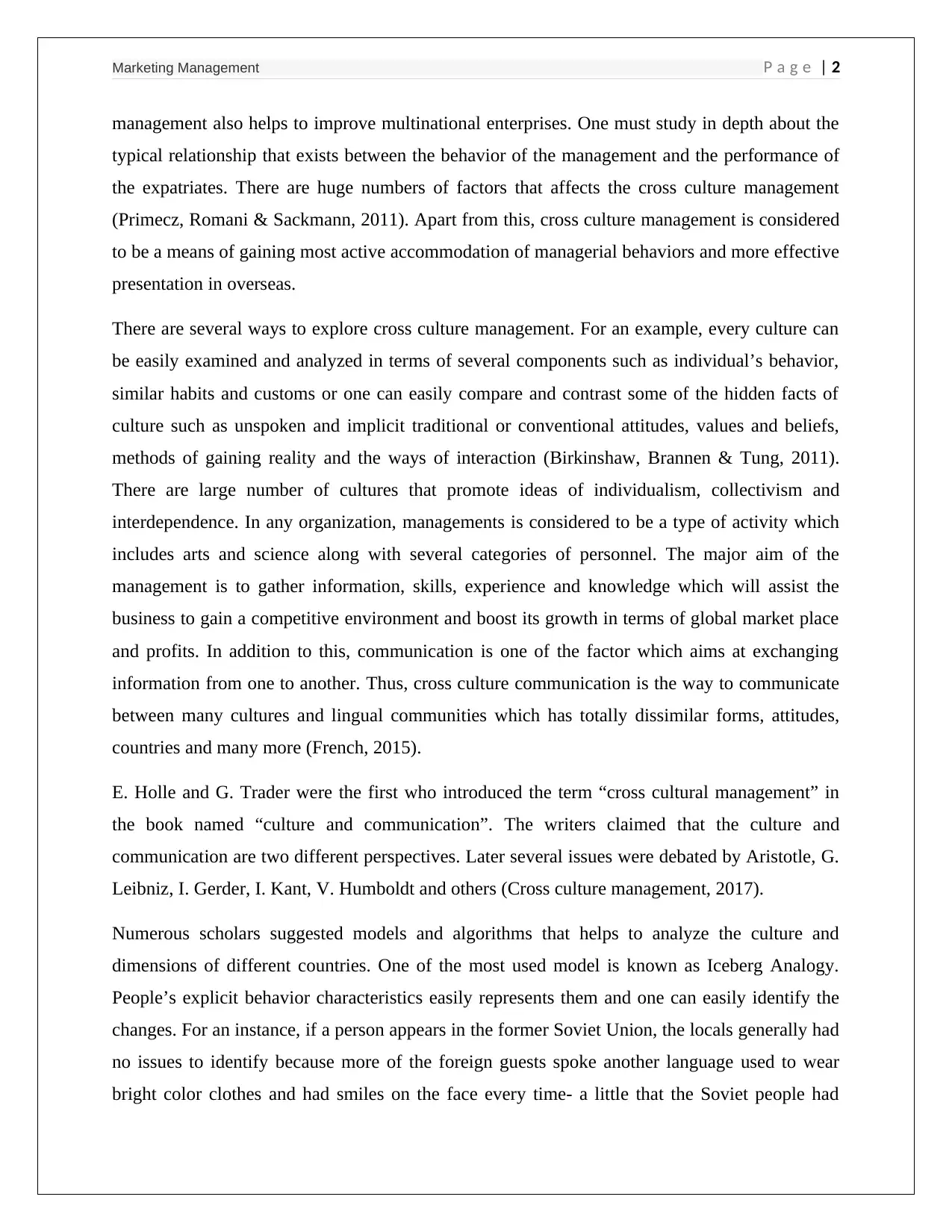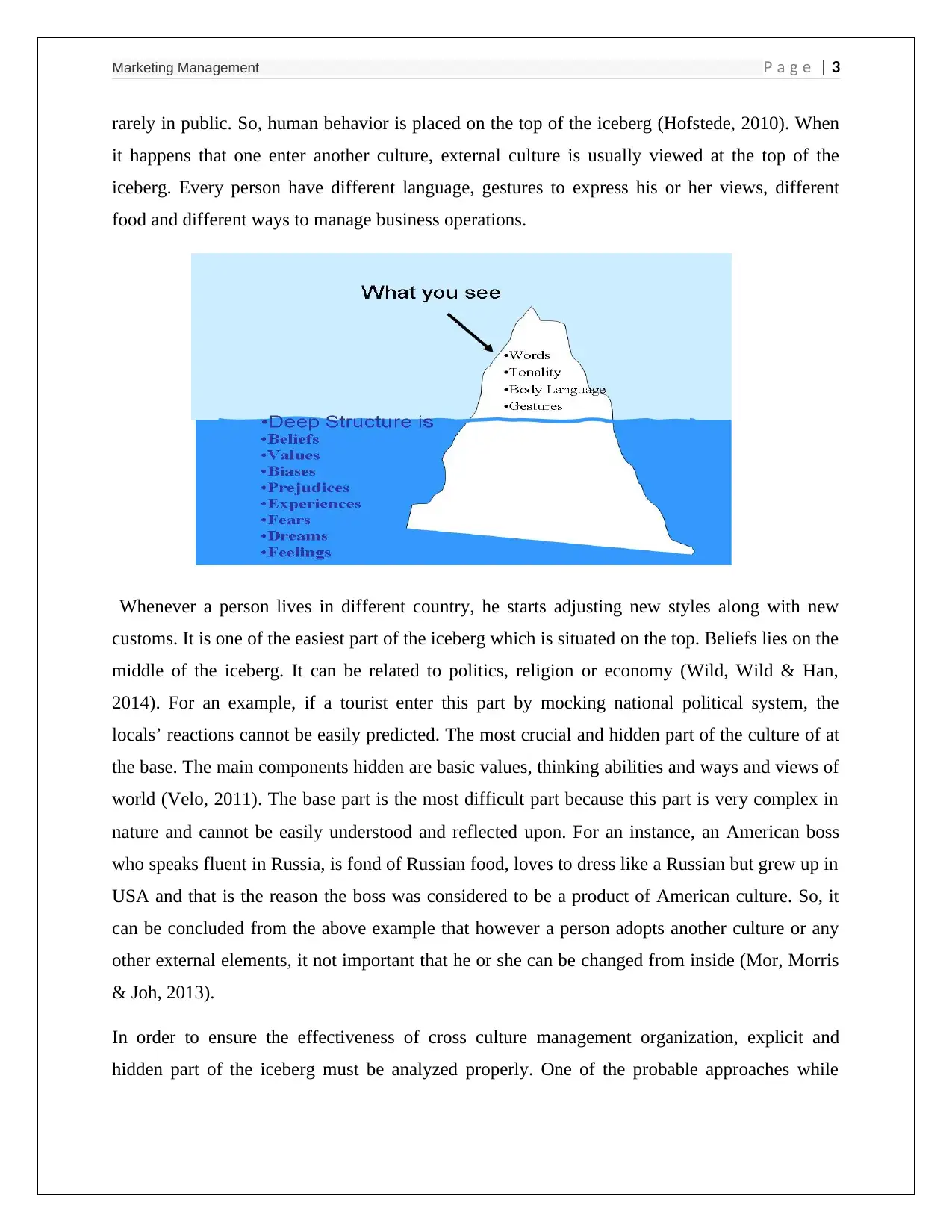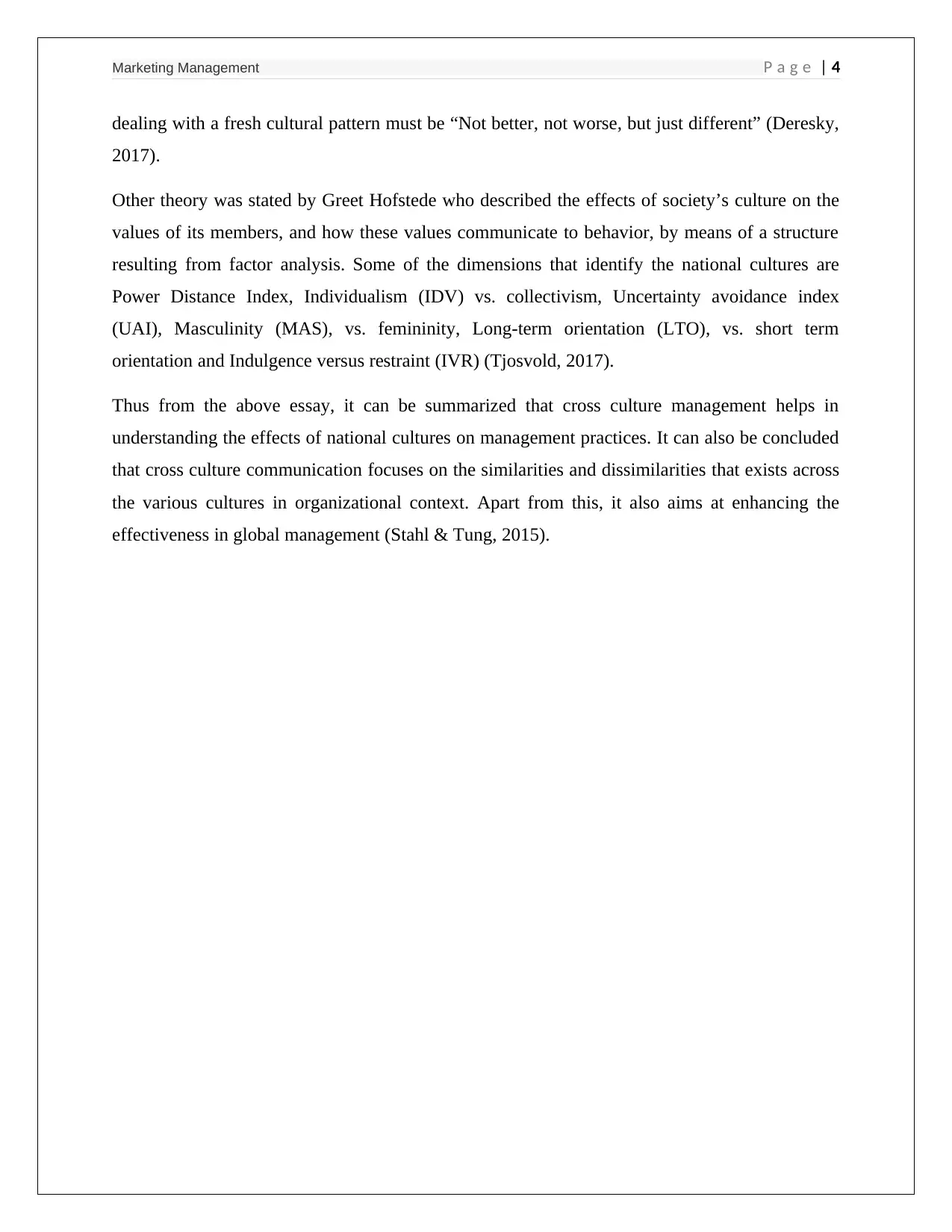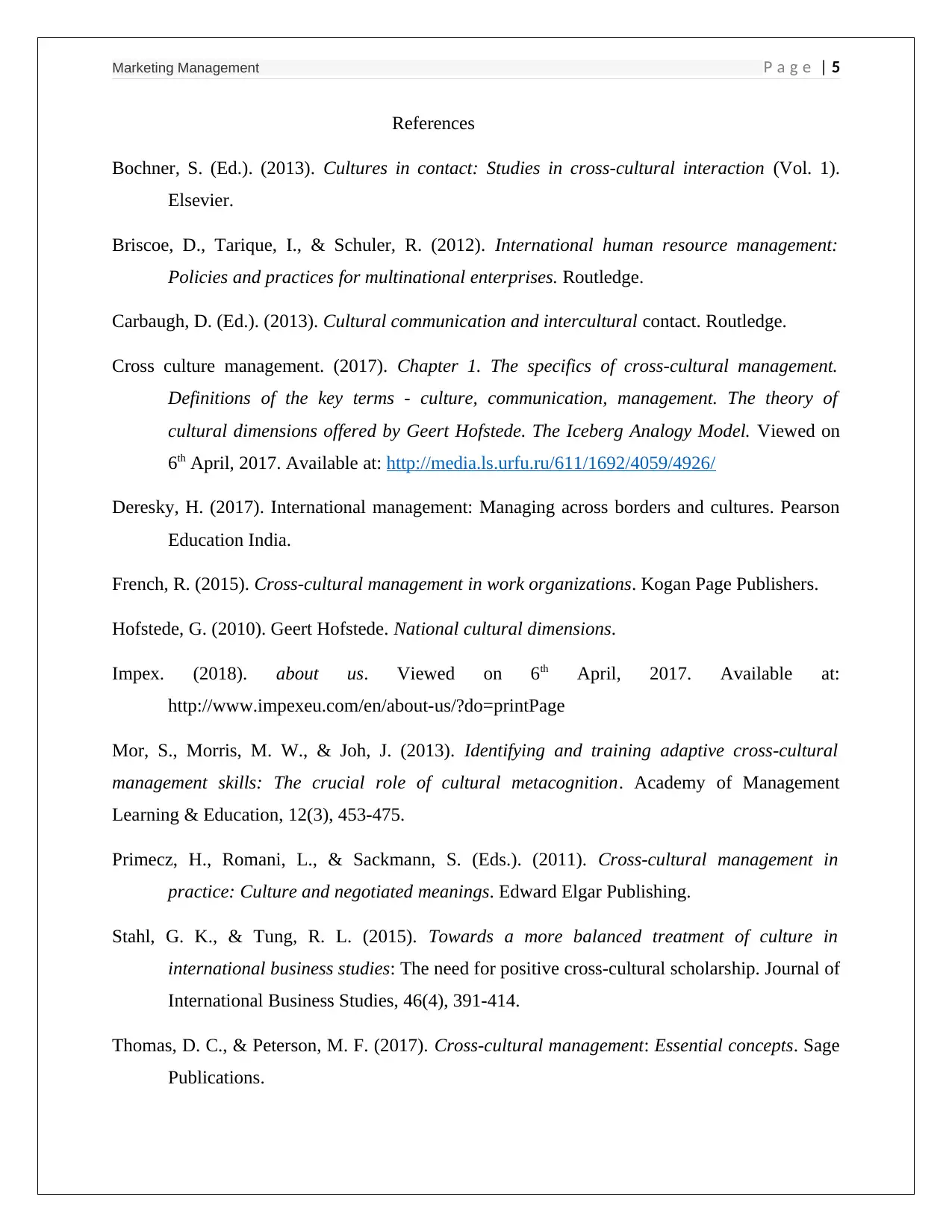Impex Europe: Cross Culture Management in International Marketing
VerifiedAdded on 2023/06/13
|7
|1916
|221
Essay
AI Summary
This essay provides an overview of cross-cultural management within the context of Impex Europe, an export management and consulting company. It defines cross-cultural management as an approach to embrace local cultures in international business, highlighting its importance in designing feasible organizational structures. The essay details Impex Europe's establishment, values, and services, emphasizing its role in supporting small and medium-sized enterprises in international trade. It discusses key concepts such as the Iceberg Analogy and Hofstede's cultural dimensions to analyze cultural differences and their impact on management practices. The essay concludes that cross-cultural management is crucial for understanding national cultures, enhancing global management effectiveness, and improving communication across diverse organizational contexts. Desklib provides access to similar essays and study tools for students.

[Date]
Marketing Management
Impex and Cross Culture Management
Student details
Email Id:
Marketing Management
Impex and Cross Culture Management
Student details
Email Id:
Paraphrase This Document
Need a fresh take? Get an instant paraphrase of this document with our AI Paraphraser

Marketing Management P a g e | 1
Cross culture management is defined as adopting comprehensive management approaches to the
culture of subsidiary nations which have different human races, different cultural types and
changed development stages of culture in the international business. Cross Culture management
is one of the most commonly used management methods which helps in embracing the local
culture. The main idea behind such culture is to design and build feasible organization or any
business structures and mechanism related to managements. These structures are built in various
procedures of culture atmosphere (Bochner, 2013).
In addition to this, ImpEx was established in 2013 as “ImpEx Europe” as a limited liability
company. The head office is situated in Riga, Latvia and it aims at allowing easy communication
and travelling across the large number countries. It is export management and consulting
company which is specialized in creating an international trade support for small and medium
scale enterprises. The company aims at sharing its expertise and supporting and developing areas
such as business process improvement, marketing, product distribution in domestic and
European market, export management outsourcing (i.e. export administration), and trade
financing and legal affairs by preparing international agreements. The company has five major
values i.e. satisfaction with what we do, versatile approach to situations, creation of added value,
honesty and integrity towards self and customers and ongoing improvement. The company has
started its operations as a partnership with a concept to help domestic and MNC companies in
order to be more competitive and enlarge business by starting selling products and services to
new and potential customers in other terrains. When the company successfully completed the
first project, later the demand for export management boosted up along with sales consulting
services. The company added more members in team and aimed at creating greater assistance in
new business partner attraction, import and export trades’ management, international trade
finance and other pitches as well (Impex, 2018).
According to Black and Porter’s paper, it was stated that cross culture management has been able
to create many successful lessons for the managers. Apart from this, it was also stated that cross
culture management is the outcomes of generation development (Carbaugh, 2013). The
globalization economy invites every individuals and communities from dissimilar human races
as well as cultures in order to study or work collectively and later create products to be easily
accepted and used by the people from several races, cultures and consuetudes. Cross culture
Cross culture management is defined as adopting comprehensive management approaches to the
culture of subsidiary nations which have different human races, different cultural types and
changed development stages of culture in the international business. Cross Culture management
is one of the most commonly used management methods which helps in embracing the local
culture. The main idea behind such culture is to design and build feasible organization or any
business structures and mechanism related to managements. These structures are built in various
procedures of culture atmosphere (Bochner, 2013).
In addition to this, ImpEx was established in 2013 as “ImpEx Europe” as a limited liability
company. The head office is situated in Riga, Latvia and it aims at allowing easy communication
and travelling across the large number countries. It is export management and consulting
company which is specialized in creating an international trade support for small and medium
scale enterprises. The company aims at sharing its expertise and supporting and developing areas
such as business process improvement, marketing, product distribution in domestic and
European market, export management outsourcing (i.e. export administration), and trade
financing and legal affairs by preparing international agreements. The company has five major
values i.e. satisfaction with what we do, versatile approach to situations, creation of added value,
honesty and integrity towards self and customers and ongoing improvement. The company has
started its operations as a partnership with a concept to help domestic and MNC companies in
order to be more competitive and enlarge business by starting selling products and services to
new and potential customers in other terrains. When the company successfully completed the
first project, later the demand for export management boosted up along with sales consulting
services. The company added more members in team and aimed at creating greater assistance in
new business partner attraction, import and export trades’ management, international trade
finance and other pitches as well (Impex, 2018).
According to Black and Porter’s paper, it was stated that cross culture management has been able
to create many successful lessons for the managers. Apart from this, it was also stated that cross
culture management is the outcomes of generation development (Carbaugh, 2013). The
globalization economy invites every individuals and communities from dissimilar human races
as well as cultures in order to study or work collectively and later create products to be easily
accepted and used by the people from several races, cultures and consuetudes. Cross culture

Marketing Management P a g e | 2
management also helps to improve multinational enterprises. One must study in depth about the
typical relationship that exists between the behavior of the management and the performance of
the expatriates. There are huge numbers of factors that affects the cross culture management
(Primecz, Romani & Sackmann, 2011). Apart from this, cross culture management is considered
to be a means of gaining most active accommodation of managerial behaviors and more effective
presentation in overseas.
There are several ways to explore cross culture management. For an example, every culture can
be easily examined and analyzed in terms of several components such as individual’s behavior,
similar habits and customs or one can easily compare and contrast some of the hidden facts of
culture such as unspoken and implicit traditional or conventional attitudes, values and beliefs,
methods of gaining reality and the ways of interaction (Birkinshaw, Brannen & Tung, 2011).
There are large number of cultures that promote ideas of individualism, collectivism and
interdependence. In any organization, managements is considered to be a type of activity which
includes arts and science along with several categories of personnel. The major aim of the
management is to gather information, skills, experience and knowledge which will assist the
business to gain a competitive environment and boost its growth in terms of global market place
and profits. In addition to this, communication is one of the factor which aims at exchanging
information from one to another. Thus, cross culture communication is the way to communicate
between many cultures and lingual communities which has totally dissimilar forms, attitudes,
countries and many more (French, 2015).
E. Holle and G. Trader were the first who introduced the term “cross cultural management” in
the book named “culture and communication”. The writers claimed that the culture and
communication are two different perspectives. Later several issues were debated by Aristotle, G.
Leibniz, I. Gerder, I. Kant, V. Humboldt and others (Cross culture management, 2017).
Numerous scholars suggested models and algorithms that helps to analyze the culture and
dimensions of different countries. One of the most used model is known as Iceberg Analogy.
People’s explicit behavior characteristics easily represents them and one can easily identify the
changes. For an instance, if a person appears in the former Soviet Union, the locals generally had
no issues to identify because more of the foreign guests spoke another language used to wear
bright color clothes and had smiles on the face every time- a little that the Soviet people had
management also helps to improve multinational enterprises. One must study in depth about the
typical relationship that exists between the behavior of the management and the performance of
the expatriates. There are huge numbers of factors that affects the cross culture management
(Primecz, Romani & Sackmann, 2011). Apart from this, cross culture management is considered
to be a means of gaining most active accommodation of managerial behaviors and more effective
presentation in overseas.
There are several ways to explore cross culture management. For an example, every culture can
be easily examined and analyzed in terms of several components such as individual’s behavior,
similar habits and customs or one can easily compare and contrast some of the hidden facts of
culture such as unspoken and implicit traditional or conventional attitudes, values and beliefs,
methods of gaining reality and the ways of interaction (Birkinshaw, Brannen & Tung, 2011).
There are large number of cultures that promote ideas of individualism, collectivism and
interdependence. In any organization, managements is considered to be a type of activity which
includes arts and science along with several categories of personnel. The major aim of the
management is to gather information, skills, experience and knowledge which will assist the
business to gain a competitive environment and boost its growth in terms of global market place
and profits. In addition to this, communication is one of the factor which aims at exchanging
information from one to another. Thus, cross culture communication is the way to communicate
between many cultures and lingual communities which has totally dissimilar forms, attitudes,
countries and many more (French, 2015).
E. Holle and G. Trader were the first who introduced the term “cross cultural management” in
the book named “culture and communication”. The writers claimed that the culture and
communication are two different perspectives. Later several issues were debated by Aristotle, G.
Leibniz, I. Gerder, I. Kant, V. Humboldt and others (Cross culture management, 2017).
Numerous scholars suggested models and algorithms that helps to analyze the culture and
dimensions of different countries. One of the most used model is known as Iceberg Analogy.
People’s explicit behavior characteristics easily represents them and one can easily identify the
changes. For an instance, if a person appears in the former Soviet Union, the locals generally had
no issues to identify because more of the foreign guests spoke another language used to wear
bright color clothes and had smiles on the face every time- a little that the Soviet people had
⊘ This is a preview!⊘
Do you want full access?
Subscribe today to unlock all pages.

Trusted by 1+ million students worldwide

Marketing Management P a g e | 3
rarely in public. So, human behavior is placed on the top of the iceberg (Hofstede, 2010). When
it happens that one enter another culture, external culture is usually viewed at the top of the
iceberg. Every person have different language, gestures to express his or her views, different
food and different ways to manage business operations.
Whenever a person lives in different country, he starts adjusting new styles along with new
customs. It is one of the easiest part of the iceberg which is situated on the top. Beliefs lies on the
middle of the iceberg. It can be related to politics, religion or economy (Wild, Wild & Han,
2014). For an example, if a tourist enter this part by mocking national political system, the
locals’ reactions cannot be easily predicted. The most crucial and hidden part of the culture of at
the base. The main components hidden are basic values, thinking abilities and ways and views of
world (Velo, 2011). The base part is the most difficult part because this part is very complex in
nature and cannot be easily understood and reflected upon. For an instance, an American boss
who speaks fluent in Russia, is fond of Russian food, loves to dress like a Russian but grew up in
USA and that is the reason the boss was considered to be a product of American culture. So, it
can be concluded from the above example that however a person adopts another culture or any
other external elements, it not important that he or she can be changed from inside (Mor, Morris
& Joh, 2013).
In order to ensure the effectiveness of cross culture management organization, explicit and
hidden part of the iceberg must be analyzed properly. One of the probable approaches while
rarely in public. So, human behavior is placed on the top of the iceberg (Hofstede, 2010). When
it happens that one enter another culture, external culture is usually viewed at the top of the
iceberg. Every person have different language, gestures to express his or her views, different
food and different ways to manage business operations.
Whenever a person lives in different country, he starts adjusting new styles along with new
customs. It is one of the easiest part of the iceberg which is situated on the top. Beliefs lies on the
middle of the iceberg. It can be related to politics, religion or economy (Wild, Wild & Han,
2014). For an example, if a tourist enter this part by mocking national political system, the
locals’ reactions cannot be easily predicted. The most crucial and hidden part of the culture of at
the base. The main components hidden are basic values, thinking abilities and ways and views of
world (Velo, 2011). The base part is the most difficult part because this part is very complex in
nature and cannot be easily understood and reflected upon. For an instance, an American boss
who speaks fluent in Russia, is fond of Russian food, loves to dress like a Russian but grew up in
USA and that is the reason the boss was considered to be a product of American culture. So, it
can be concluded from the above example that however a person adopts another culture or any
other external elements, it not important that he or she can be changed from inside (Mor, Morris
& Joh, 2013).
In order to ensure the effectiveness of cross culture management organization, explicit and
hidden part of the iceberg must be analyzed properly. One of the probable approaches while
Paraphrase This Document
Need a fresh take? Get an instant paraphrase of this document with our AI Paraphraser

Marketing Management P a g e | 4
dealing with a fresh cultural pattern must be “Not better, not worse, but just different” (Deresky,
2017).
Other theory was stated by Greet Hofstede who described the effects of society’s culture on the
values of its members, and how these values communicate to behavior, by means of a structure
resulting from factor analysis. Some of the dimensions that identify the national cultures are
Power Distance Index, Individualism (IDV) vs. collectivism, Uncertainty avoidance index
(UAI), Masculinity (MAS), vs. femininity, Long-term orientation (LTO), vs. short term
orientation and Indulgence versus restraint (IVR) (Tjosvold, 2017).
Thus from the above essay, it can be summarized that cross culture management helps in
understanding the effects of national cultures on management practices. It can also be concluded
that cross culture communication focuses on the similarities and dissimilarities that exists across
the various cultures in organizational context. Apart from this, it also aims at enhancing the
effectiveness in global management (Stahl & Tung, 2015).
dealing with a fresh cultural pattern must be “Not better, not worse, but just different” (Deresky,
2017).
Other theory was stated by Greet Hofstede who described the effects of society’s culture on the
values of its members, and how these values communicate to behavior, by means of a structure
resulting from factor analysis. Some of the dimensions that identify the national cultures are
Power Distance Index, Individualism (IDV) vs. collectivism, Uncertainty avoidance index
(UAI), Masculinity (MAS), vs. femininity, Long-term orientation (LTO), vs. short term
orientation and Indulgence versus restraint (IVR) (Tjosvold, 2017).
Thus from the above essay, it can be summarized that cross culture management helps in
understanding the effects of national cultures on management practices. It can also be concluded
that cross culture communication focuses on the similarities and dissimilarities that exists across
the various cultures in organizational context. Apart from this, it also aims at enhancing the
effectiveness in global management (Stahl & Tung, 2015).

Marketing Management P a g e | 5
References
Bochner, S. (Ed.). (2013). Cultures in contact: Studies in cross-cultural interaction (Vol. 1).
Elsevier.
Briscoe, D., Tarique, I., & Schuler, R. (2012). International human resource management:
Policies and practices for multinational enterprises. Routledge.
Carbaugh, D. (Ed.). (2013). Cultural communication and intercultural contact. Routledge.
Cross culture management. (2017). Chapter 1. The specifics of cross-cultural management.
Definitions of the key terms - culture, communication, management. The theory of
cultural dimensions offered by Geert Hofstede. The Iceberg Analogy Model. Viewed on
6th April, 2017. Available at: http://media.ls.urfu.ru/611/1692/4059/4926/
Deresky, H. (2017). International management: Managing across borders and cultures. Pearson
Education India.
French, R. (2015). Cross-cultural management in work organizations. Kogan Page Publishers.
Hofstede, G. (2010). Geert Hofstede. National cultural dimensions.
Impex. (2018). about us. Viewed on 6th April, 2017. Available at:
http://www.impexeu.com/en/about-us/?do=printPage
Mor, S., Morris, M. W., & Joh, J. (2013). Identifying and training adaptive cross-cultural
management skills: The crucial role of cultural metacognition. Academy of Management
Learning & Education, 12(3), 453-475.
Primecz, H., Romani, L., & Sackmann, S. (Eds.). (2011). Cross-cultural management in
practice: Culture and negotiated meanings. Edward Elgar Publishing.
Stahl, G. K., & Tung, R. L. (2015). Towards a more balanced treatment of culture in
international business studies: The need for positive cross-cultural scholarship. Journal of
International Business Studies, 46(4), 391-414.
Thomas, D. C., & Peterson, M. F. (2017). Cross-cultural management: Essential concepts. Sage
Publications.
References
Bochner, S. (Ed.). (2013). Cultures in contact: Studies in cross-cultural interaction (Vol. 1).
Elsevier.
Briscoe, D., Tarique, I., & Schuler, R. (2012). International human resource management:
Policies and practices for multinational enterprises. Routledge.
Carbaugh, D. (Ed.). (2013). Cultural communication and intercultural contact. Routledge.
Cross culture management. (2017). Chapter 1. The specifics of cross-cultural management.
Definitions of the key terms - culture, communication, management. The theory of
cultural dimensions offered by Geert Hofstede. The Iceberg Analogy Model. Viewed on
6th April, 2017. Available at: http://media.ls.urfu.ru/611/1692/4059/4926/
Deresky, H. (2017). International management: Managing across borders and cultures. Pearson
Education India.
French, R. (2015). Cross-cultural management in work organizations. Kogan Page Publishers.
Hofstede, G. (2010). Geert Hofstede. National cultural dimensions.
Impex. (2018). about us. Viewed on 6th April, 2017. Available at:
http://www.impexeu.com/en/about-us/?do=printPage
Mor, S., Morris, M. W., & Joh, J. (2013). Identifying and training adaptive cross-cultural
management skills: The crucial role of cultural metacognition. Academy of Management
Learning & Education, 12(3), 453-475.
Primecz, H., Romani, L., & Sackmann, S. (Eds.). (2011). Cross-cultural management in
practice: Culture and negotiated meanings. Edward Elgar Publishing.
Stahl, G. K., & Tung, R. L. (2015). Towards a more balanced treatment of culture in
international business studies: The need for positive cross-cultural scholarship. Journal of
International Business Studies, 46(4), 391-414.
Thomas, D. C., & Peterson, M. F. (2017). Cross-cultural management: Essential concepts. Sage
Publications.
⊘ This is a preview!⊘
Do you want full access?
Subscribe today to unlock all pages.

Trusted by 1+ million students worldwide

Marketing Management P a g e | 6
Tjosvold, D. (2017). Cross-cultural management: foundations and future. Routledge.
Velo, V. (2011). Cross-cultural management. Business Expert Press.
Wild, J. J., Wild, K. L., & Han, J. C. (2014). International business. Pearson Education Limited.
Tjosvold, D. (2017). Cross-cultural management: foundations and future. Routledge.
Velo, V. (2011). Cross-cultural management. Business Expert Press.
Wild, J. J., Wild, K. L., & Han, J. C. (2014). International business. Pearson Education Limited.
1 out of 7
Related Documents
Your All-in-One AI-Powered Toolkit for Academic Success.
+13062052269
info@desklib.com
Available 24*7 on WhatsApp / Email
![[object Object]](/_next/static/media/star-bottom.7253800d.svg)
Unlock your academic potential
Copyright © 2020–2025 A2Z Services. All Rights Reserved. Developed and managed by ZUCOL.




